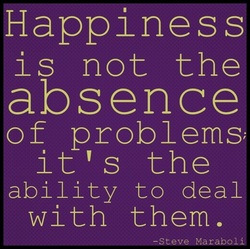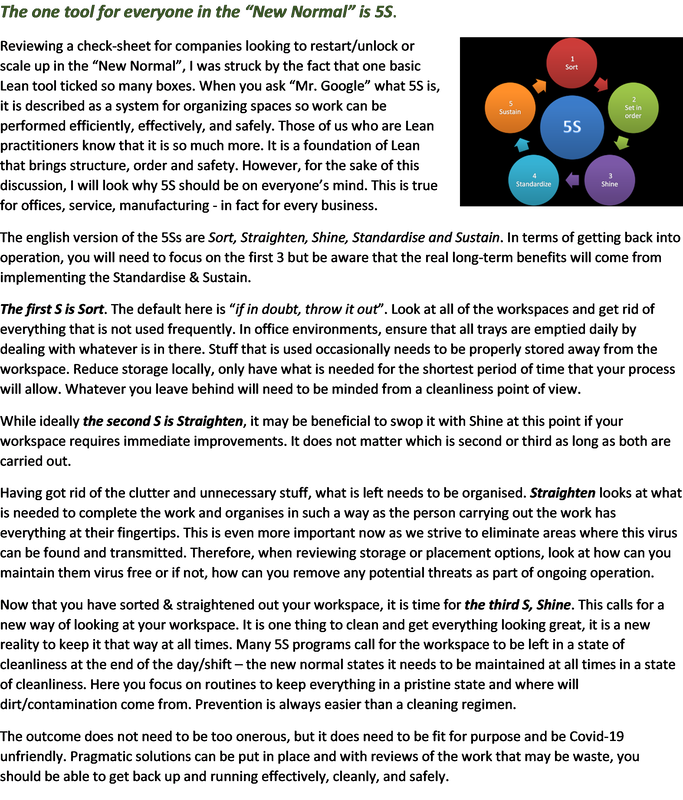|
Create the Capacity required in the “New Normal”.
A positive, if there is to be one, of the current situation, is that it will force change – there is no going back to the way it was. The “New Normal” will require more space, more time or more effort to do what you used to do. Thus, you must create capacity to allow this to happen without adding cost and making the enterprise less competitive. The easiest place to create capacity is to look at the work you do and decide if it is Value Add (VA) or Non-Value Add (NVA). Is the element of work/service that you look at something that your customer actually wants you to do (VA)? If it is not VA, then it is NVA and is classed as waste to be eliminated. The “We’ve always done it this way” must become the “We used to do it that way”. Identify all the work/tasks that you carried out and ask two simple questions. Firstly, “If I told my customer I do this, would they say yes, we’ll pay for that?” If the answer is no, then ask yourself the second question “Why am I doing it?”. If you have no logical reason, then simply stop doing it. By the way, the second question is always the hardest. Beyond this, you must also focus on what will your operations look like when the dust settles. How much change will there be at your place of work? How much will be remote/virtual? How will that be managed? What can be done remotely and what cannot? This will be different for every business no matter what the sector.  To those of you that partake in the various forms of martial arts, a “Kata” is nothing new. Described as a routine of moves and patterns of movement that is practiced to various levels of mastery at the start of any martial arts session, its purpose is to ingrain the movements into your subconscious so that when called on to use them, you do so instinctively without thought. In modern times the word “Kata” is being used to describe generic routines outside of martial arts that are practiced by individuals and/or organizations. The current focus of most “Lean” leaders is to help organizations create the behavioral culture that Lean needs to thrive – this is the missing part of the puzzle as to why the systems developed by Toyota & others do not translate well into western cultures. Mike Rother calls the creation & maintenance of this behavioral culture at Toyota as the “Toyota Kata”. Now to many this sounds both complex and a lot of work but it isn't. What it is in its simplest form, is consistency. Which is why, in martial arts, it is practiced at every possible occasion. Remember your old (insert sport of choice) coach who would consistently tell you that “Practice makes perfect”. So, how do we go about creating your own “Kata”. This can be started whether or not you are implementing Lean in any form as it makes nothing but good sense. Simply decide what kind of culture you want within your organisation/department/group and then decide what are the behaviors that will foster such a culture. Apologies to those change managers out there, but to get started you don’t need a consultant or even a book or course. Make your behaviors your routine, your "Kata". Just do it! Easier said than done? Not really. Start with some basic Credos by which you will operate. Agree these among you group. Now, here is a golden gem in terms of it working, make this your first Credo #1 - Agree a method of highlighting inconsistency – that is, when you or your group is not consistently behaving as per your credos, it is praised when someone stops and says so. This can be difficult at the start because people may take being challenged personally and so become defensive. Watch out for this and look to create an environment where its ok to challenge. As the leader, you may wish to deliberately go offside on a couple of occasions and praise those who call you to order. What are the other Credos that you should use? Here are few to get started. Credo # 2 : This is the fundamental belief that you should always “Do good!” This will need to be one of your underlying cornerstones as you go forward. It should be part of your natural thought process when working as there will be times that you will have to make decisions with limited information. Another way of looking at this is the expression “Do not let the Best be the enemy of Good” or take what you can when you can in terms of benefits, improvements and/or cultural changes. Credo # 3 : Unfortunately, experience teaches us that the one thing that is not common in today’s business world is “We Live by Common Sense” . It should be the part of your natural thought process where you ask yourself, does this make sense. There are times where very reasonable people, who use common sense at home but when at work can make suggestions that, are at odds with common sense. You will need to watch for this constantly. When obvious, use Credo #1 to challenge. Credo # 4 : The Honorary Chairman of Toyota, Fujio Cho, is credited with the expression of “Go see, Ask why, Show respect!” This should be the third cornerstone of how you behave and as important how you expect your group to behave. The solution is always in Gemba (the workplace), the information is there if you ask for it and you must always respect everyone equally. This is one of the positive differences that allows very successful Lean organizations to create the correct culture. Credo # 5 : The most powerful cornerstone is to identify “WIIFM – What’s In It For Me?”. This must be at all times to the forefront of your thought processes as it is critical to address in everything that you do. If properly used, it is a very powerful tool in your arsenal. Credo # 6 : The final cornerstone is “Zero Blame”. The natural reaction to bad news is who is to blame. In some organizations, every major negative issue that they must deal with is resolved with someone being fired. Just look at the daily papers clamoring for heads to roll not matter what the situation. This creates a negative environment that will not sustain what you are trying to achieve. This particular behavior must be evident at all levels. Remember that your group will take their lead from you, so strive to be consistent. Dermot 18th April 2014. Know someone who’d enjoy reading this blog? Forward it on or ask them to contact [email protected] and we will add them to the mailing list. If you’d like to have a discussion about Lean or Strategy Deployment or mentoring, give me a call on 00353 87 2429433.  Just about every FDI multinational organization operating in Ireland has a Continuous Improvement or Lean program. Our indigenous SME companies are, sadly, a different story. This is all the more confusing given that there is 30% plus in savings opportunities available from an effective Lean program, no matter what your business is. Why, therefore, is there such poor take-up of the benefits? Over the recent past I have been discussing this with several SME owners and their views were similar. Their main reason was that they tune out the minute they hear mention of Lean, the number one car manufacturer in the world or indeed, any Japanese word. Their eyes go glossy and their smart phones are picked up. “It is not relevant to us or our business and anyway, we’re too busy!” Nothing could be further from the truth. It is relevant to every business and its benefits may be the difference between survival and failure. It forces you to look at how the business is run, to eliminate what are controllable elements that are pure waste and finally focus on your customer. Get rid of the wasteful activities and you will have all the time you need not to be busy. It is not difficult to do and every company can do it. There is even significant support by way of grants from Enterprise Ireland by way of their “Lean Start” programs. What do I mean by waste elimination? Let’s look at some simple examples. A service organization spend the equivalent of 56 man-days preparing their month end reports spread over the 5 days either side of the actual month end. It also required most of the 7 people involved working at least 3 or 4 long 10 hour days. After a full review it was decided that 35% of the reports were never read, a further 25% might be used as a reference later and of the remaining 40%, they were able to amalgamate some to reduce it to 25% with the remaining reference information supplied on an as needed basis. Thus month end was reduced to 14 man-days, no long hours and the ability to take on other work that was being neglected. Guess who the hero in that organization was! A small processor in the food service industry had a 2 man production unit that spent only 2.5 hours a day actually producing product. The rest of the time was spend going to various parts of the facility to get the materials that were needed, waiting for the upstream process to deliver their supplies and various other wastes. Working with the people at the job, some basic pre-kitting of materials for orders and a re-layout of the workplace they were able to increase this to 6 hours per day without any extra resources from within the business. In essence, an extra person! A plastic processing company had the good fortune to win extra business but between the raw materials needed, the new equipment and the holding of finished goods for their customers, they were faced with having to add up to 50% extra space. This would mean a new building. However, with some work with their suppliers, creative storage of their work in progress and an agreement with their customers to a daily “milk run”, they were able to free up all the space they needed for their new business and thus avoid a second facility. All of that extra profit! These examples are indicative of what can be achieved by all sizes of companies working in all types of business arenas. Waste is waste no matter what you do. NON VALUE ADDED work is the work that we do that the customer doesn’t want to pay for and the accepted figure for this element of our businesses is 95%. Despite over 50 years of implementing Lean, the company that makes the best built cars in the world, has only managed to get this down to 89% - so there is no shortage of opportunity. However, a move from 5% to 6% is only a movement of 1% in the reduction of waste but it represents an improvement of 20% in our productivity. Another area where significant gains can be made is by listening to the “Voice of your Customer”. Most customers do not necessarily buy the cheapest available but rather will do business with and/or look to build a relationship with a supplier that offers value for money and that is concerned about their service. Huge benefits can be had from talking to your customer, listening to their needs and most importantly acting on what you find out. Smaller companies had a big advantage here in that it is easier to react quickly and see the benefits. Again some examples. A small boutique hotel was suffering with the downturn and following discussions at several networking groups discovered that when business people finally get to their hotel room they are usually ready for a relaxing moment and often don’t want to have to go out to eat. To aid this, the hotel put a complimentary (airplane size) bottle of 15 yr old whiskey in every room and offered a dish of the pasta of the day in lieu of breakfast. They had an occupancy rate of double the surrounding hotels but more importantly, an 85% loyalty rate among its clients. A florist was looking for new ways to drum up business and noticed that most of the area in which they served was apartments usually for single people. So they went and talked to their potential customers namely men (“why would they buy flowers?”) and women (“When would they be swayed by flowers?”) They did so in local bars and restaurants over a number of weekends. They came up with a complete range pre prepared bouquets for novel occasions that conveyed a message that can be ordered by text and delivered that day. Some of these include the “Wow” (subtext, that was wonderful, can we meet again), the “Whoops” (subtext: sorry, I really am…) and the “Prayer” (subtext: please, honey, don’t call the solicitors). Business trebled when simple laminated A4 brochures were placed in every apartment block lobby. The key here was that both went to ask their actual customers what they wanted and not what they themselves though their customers needed. For some reason it is easier to internalize this process and not talk to or involve our customer. Figure that one out! Finally, in my discussions with SME owners, I discovered a problem that we, the experts, are creating. There is a form of snobbery & elitist complexity being created around Lean by our overuse of Japanese terms and cofusing terminology. Lean is about common sense being used the same way all of the time. Some of the longest discussions in LinkedIn groups are around “What does Lean mean to them?” The Japanese are very clear about this. It means that they train their people to consistently improve what they do every day. Their credo of “Go See, Ask Why & Show Respect” means that they go to the place of work, validate for themselves what is the problem and work, with respect with those who work there, to find the root cause which they then fix. Their over-riding focus is about fixing problems and eliminating waste. But they use words that mean something to their employees, that speak to their language and customs. We need to do the same. Therefore, having listened to my customers and in an effort to simplify Lean, this entire piece has been written without reference to any Japanese word nor has it mentioned any car manufacturer by name. There are some Japanese terms and words which have crept into our day to day language and we need to understand their meaning but for today, we will do without them. We need to teach the excellent tools and techniques of Lean with reference to our local customs, language and practices. This way we modify them to be fit for purpose and make them relevant for all our businesses large and small. I have decided to track a new metric – “Length of time from the start of my presentation to when the first smart phone is picked up, divided by the total length of time of the presentation and measured as a percentage”. The last one was 62%, so clearly I have some way to go. However, should someone need to take a new Japanese word away with them, try this one - “Oushikuso” – Google it! - I may just make an exception and use this one a lot. Dermot. PS Please leave a comment whether you agree or disagree as it is only with feedback I can improve or save you all from future torture whichever is the more applicable.  Over recent times, as I visit various companies both large and small, I am often struck by a phenomenon that I call “Trench” mentality. This is the helter skelter activity of trying to keep going in this current mad business world that we find ourselves in and although not all behave like headless chickens, there is a sense of backs to the wall, where all bets are off and we do what we have to do just to stay afloat. This I have seen in both SME & FDI subsidiaries. “Trench” needs to have a short shelf life and those in the company are looking to you, the leader, to show guidance to get them all out of there. What I am about to suggest, therefore, may seem like pouring hot oil on to an already blazing fire. I want you to look to the future. “Ya What?” says Gay, but hear me out. If we don’t look past today, then we won’t be able to profit from the upturn in business when it comes – and it will come. If I could tell you when, I wouldn’t be writing this blog! Notwithstanding that minor detail, now is the time to plan for the future but what I am suggesting will also help you with today. No matter what your business model is (service, product, process, etc) there are certain tools & techniques that can help now while preparing for the future. Firstly, create your Value Stream Map(VSM) for your processes/work flow. There are many types that can be used and there is one for your business model. This does three things. It will allow you to see where there is waste in your current set up which can be worked on to reduce your current cost. It will allow you to look to the future and create what would be your ideal state. Now you have a gap between there and here which you can plan to bridge over time. These are standard Lean techniques. However, a new use for VSMs is to use them to future proof your business. You can stress your current and future processes. What if your business grew by 20% or 50% or even 100% in a short space of time as you come out of the recession? Now use your VSM to see how your business will behave and identify critical points where action is needed. As a corollary, this method can be used to see what happens if your business goes the other way. Next, talk to your customers. Illicit complaints and fix them. A complaint is a customer outcome you can change from negative to positive. Too many businesses look at complaints as a metric you have to drive down. Wrong. Nurture complaints and develop an internal response that is fast and addresses the issues. Use problem solving techniques to enhance this process. Some of the best products on the markets are as a result of improvements achieved from root causing customer complaints. Now that you are talking, ask your customers about their business, how can you help them, what kind of notice will you get if their business picks up. In these days of Pull, Kanban, JIT and VMI all along the supply chain, you need information quickly if you are to respond. Now is the time to agree & to put in place the necessary signals. A useful Lean tool that can be used to help manage your business in these times is called Demand Response Profile. What this focuses on is the level of growth you can have before you have to make changes to your organization (again, like above, this works both ways). How much extra business can you absorb before overtime becomes permanent or at what level will you need to add capacity be it process, shifts or people? By identifying these stress points, you can be ready for the upturn and be proactive in terms of your business needs, particularly if there are training needs that take time. It will also allow you to know where action is needed if a downturn occurs. One of the identified reasons why companies don’t trade out of difficulties is slowness to react to changing fortunes. If you have suppliers, can they turn on the supply if your business grows? What are their critical supply points and does it make sense to plan for another back-up supplier? This is also a good time to negotiate for the future. Try and get your supplier to agree to volume rebates so that you get the benefits when growth occurs (just hope that your customer isn’t on my mailing list). You will be too busy when it happens to go back to negotiate and by then you’ll be over a barrel for supply. Finally, since you are now in the talking mood, if you are not already, talk to your staff. Get out of your office and walk Gemba. John C. Maxwell (a leadership guru) states that “people don't care how much you know until they know how much you care”. Get out there and walk the talk. Tell them the whole story, warts and all. They will work with you if they feel they are involved and that goes if business is growing or shrinking. Address their needs; don’t leave any elephants in the room. I have a saying (from Toyota) of ”Go See, Ask Why and Show Respect.” If you do all three, then you will have a loyal, energized staff to fight whatever challenges come your way. Every business needs a strategy and how that strategy is deployed is the subject of another rant. However, in these days of “Trench” business, take the time out to look out in front of you. Let others do the day to day jobs to allow you the time, space and mental energy to start planning for the coming upturn. The boy scouts have the right motto – Be Prepared. Dermot Know someone who’d enjoy reading this blog? Forward it on or ask them to contact [email protected] and we will add them to the mailing list. If you’d like to have a discussion about Lean or Strategy Deployment or mentoring, give me a call on 091 485 676 or 087 242 9433.  Every Opportunity is a Problem! All companies, from the single trader up to the multinational organisation need a strategic plan to drive the future of their business. Whether the goal is to increase footfall across the entrance to your retail premise or to develop the next wonder drug or mousetrap, you need to sit down and think of what are the critical strategies needed to achieve this. Most small organisations do this inherently as they struggle to survive or grow – most owner operators have a single vision that allows them to tirelessly drive forward the business. As you get larger, the vision at the top can still be there but it becomes less clear as you go down the organization. Everyone has a stake in the future of any business, so it follows that they should have an input in to achieving its success. This is easily done and can be very powerful, but it requires some work and trust. A simple test is to walk into your work area, whatever that is, and ask any employee “what tasks are you involved in this month that are part of an element of the strategic plan?” Most will look at you as if you have just asked them how to split an atom and, depending on your IR relationship, they may even view this as a trick question. How many organisations have taken their senior team away for 2 to 3 days in a (insert suitable adjective – nice, plush, overseas, etc) hotel to develop the ”Strategic Plan”? How many have then come back and delivered said plan with much hooting of horns and flag waving? How many then get on with the day to day running of the business and forgot about the plan? How many of the staff shrug it off saying it’s the latest plan and it will fade away over time? Sound familiar? Unfortunately the percentage answering positively is likely to be the same to all of the questions above. In time, some of what is in the plan is partly achieved by virtue of the fact that it influences our decision-making process. But the benefits that could have been accrued are nowhere near their potential and not at all timely. The development of the plan is not the problem, every organization needs one. It’s what you do with it once you have created it. How do you make it real to everyone no matter what their position in the organization is? How can they contribute to its success in a real and practical way every day they come to work? A favorite quote of management gurus is that “every problem is an opportunity”. The reverse can also be true, that is “every opportunity (strategy goal) is a problem”. Many have spent enormous amounts of time and money developing problem solving techniques at all levels for their businesses. Now let’s use these skills to drive our businesses forward. Let’s create problems to solve. Look at a strategic goal of say, “Increase sales by 50% in 5 years”. Turn it around and create a problem, “Sales are currently at 66% of target”. Now use the problem solving skills to solve this problem and drive it down to all levels. At each level break it down into smaller actions until you end up with a series of tasks that need to be completed to achieve the strategic goal. Now here’s the hard bit – involve everyone in the deciding of what needs to be completed and make them responsible for completing the work. Now they know what the plan is and what they are doing to achieve it. Well it’s not too hard if you think about it – its common sense. Yet why do so many organisations fall down on this one aspect? Why is it so hard for us to involve all levels of an organization in its future? Within any organization you need different skillsets to complement each other to achieve success but who is to say that only the top management in an organization can deliver on the strategy needed. By way of example, a group of Harvard researchers were given unparalleled access to over 20 companies that had failed in an effort to come up with what are the common denominators for the failures. What they found was that there was no common denominator – each company failed for their own specific reason. However, what they did find out was that there was a common thread in the fact that less than 10% of the top management knew the reason the company was about to fail whereas over 80% of those on the ground floor of the company knew exactly why it would fail. What’s more is that they could have told management had they been asked! I know hindsight is 20:20 but .................. Dermot Know someone who’d enjoy reading this blog? Forward it on or ask them to contact [email protected] and we will add them to the mailing list. If you’d like to have a discussion about Lean or Strategy Deployment or mentoring, give me a call on 087 2429433. |
AuthorDermot Freeman is a Master Lean Black Belt Lecturer and Consultant in Problem Solving & Strategic Deployment. Archives
June 2020
Categories |

|
|



 RSS Feed
RSS Feed
